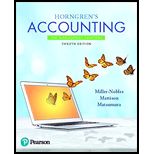
Concept Introduction:
FIFO- Perpetual inventory System: FIFO (First in first out) method assumes the flow of inventory in the same order of its purchase. In other words, the oldest purchase is assumed to be sold first in order of purchases made. The FIFO method can be applied using perpetual or periodic method. In the perpetual inventory method, the inventory balance is updated after each inventory transaction.
Recording of business transactions: Business transactions are recorded in the form of journal entries, using double entry system. In the double entry system each transaction affects at least two accounts. One or more account is debited and one or more accounts are credited for a transaction.
Posting of journal entries to ledgers: Each recorded
To post: The general entries in the ledger accounts
Want to see the full answer?
Check out a sample textbook solution
Chapter 6 Solutions
Horngren's Accounting (12th Edition)
- Can you solve this general accounting question with the appropriate accounting analysis techniques?arrow_forwardSiemens Technology produces ergonomic keyboards for $75.00 per unit. The variable cost per unit is $27.00. Each keyboard requires 4 direct labor hours and 6 machine hours to produce. Which of the following is the correct contribution margin per machine hour? a) $8.00 b) $12.00 c) $19.00 d) $48.00 e) None of these.arrow_forwardI need assistance with this general accounting question using appropriate principles.arrow_forward
- Please provide the correct answer to this general accounting problem using accurate calculations.arrow_forwardI need help finding the accurate solution to this general accounting problem with valid methods.arrow_forwardPlease provide the solution to this general accounting question with accurate financial calculations.arrow_forward
- Please explain the solution to this financial accounting problem with accurate principles.arrow_forwardPlease provide the solution to this general accounting question using proper accounting principles.arrow_forwardI am looking for a reliable way to solve this financial accounting problem using accurate principles.arrow_forward
- I am looking for the correct answer to this general accounting question with appropriate explanations.arrow_forwardCan you solve this financial accounting problem using appropriate financial principles?arrow_forwardI need help solving this Financial accounting question with the proper methodology.arrow_forward

 AccountingAccountingISBN:9781337272094Author:WARREN, Carl S., Reeve, James M., Duchac, Jonathan E.Publisher:Cengage Learning,
AccountingAccountingISBN:9781337272094Author:WARREN, Carl S., Reeve, James M., Duchac, Jonathan E.Publisher:Cengage Learning, Accounting Information SystemsAccountingISBN:9781337619202Author:Hall, James A.Publisher:Cengage Learning,
Accounting Information SystemsAccountingISBN:9781337619202Author:Hall, James A.Publisher:Cengage Learning, Horngren's Cost Accounting: A Managerial Emphasis...AccountingISBN:9780134475585Author:Srikant M. Datar, Madhav V. RajanPublisher:PEARSON
Horngren's Cost Accounting: A Managerial Emphasis...AccountingISBN:9780134475585Author:Srikant M. Datar, Madhav V. RajanPublisher:PEARSON Intermediate AccountingAccountingISBN:9781259722660Author:J. David Spiceland, Mark W. Nelson, Wayne M ThomasPublisher:McGraw-Hill Education
Intermediate AccountingAccountingISBN:9781259722660Author:J. David Spiceland, Mark W. Nelson, Wayne M ThomasPublisher:McGraw-Hill Education Financial and Managerial AccountingAccountingISBN:9781259726705Author:John J Wild, Ken W. Shaw, Barbara Chiappetta Fundamental Accounting PrinciplesPublisher:McGraw-Hill Education
Financial and Managerial AccountingAccountingISBN:9781259726705Author:John J Wild, Ken W. Shaw, Barbara Chiappetta Fundamental Accounting PrinciplesPublisher:McGraw-Hill Education





